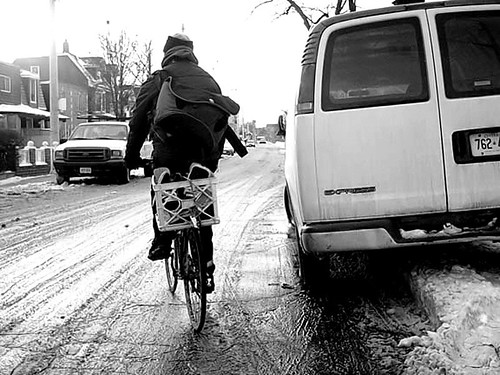
I was at a meeting of cyclists last night when the topic of cycling in the winter came up. One person made a reference I have heard before: that in Scandinavian cities with a similar winter temperature and snowfall to Toronto, 30% of people commute by bicycle.
The reference is to Copenhagen, Denmark, whose successful cycling-friendly policies have become well-known thanks to the film Contested Streets. According to the movie, something like 30% of commuter trips in the city are by bicycle (by 2006, the number was 36%). But is its winter climate really comparable to Toronto’s? I decided to check.
Here are Toronto’s average high and low temperatures during winter months (in degrees Celsius) according to the BBC Weather Centre:
December: Min -6 Max +1
January: Min -9 Max -1
February: Min -9 Max -1
March: Min -5 Max -1
Here are Copenhagen’s average high and low temperatures during the same months:
December: Min +1 Max +4
January: Min -2 Max +2
February: Min -3 Max +2
March: Min -1 Max +5
The difference is pretty significant – the average maximum in Copenhagen does not drop below freezing, and the variations are much more moderate — it does not get nearly as cold (bearing in mind that people commute in the morning and late afternoon, when the temperature is not at its maximum). While Copenhagen is hardly temperate, its winter cannot be considered as severe as Toronto’s.
As for snowfall, Toronto’s average yearly snowfall is around 144 cm (55.5 in). I found it hard to track down the equivalent statistic for Copenhagen, possibly because snowfall seems to be rare and not heavy. In fact, a Copenhagen blog about biking in the rain doesn’t even consider the possibility of snow. Information about Denmark as a whole describes snowfalls as occasional but shortlived, with little accumulation. Once again, Copenhagen’s situation is not really comparable to Toronto’s, where snowfall is erratic but at times significant.
Not only is Copenhagen’s winter weather fairly different from Toronto’s, but it is different in significant ways: there is far less freezing, with the consequent dangers of ice, not to mention physical discomfort, and there is rarely significant snow on the road.
Copenhagen is a great model for how to create a bike-friendly city, but it is not all that relevant for the issue of biking in Toronto winters.
Other, more northerly Scandinavian cities may have winters more similar to Toronto, but I do not believe that they have a comparable volume of cyclists to Copenhagen.
Note: statistics varied somewhat depending on the source consulted, but not significantly.
photo by Martin Reis




21 comments
you should ask the people at spacing.montreal to comment on winter cycling in montreal. the bike couriers in that city are unbelievable, studded tires and all!
Studded tires are the %&@#! I no longer have any fear of ice. Uncleared snow and slush, not so happy. As for all the salt, what gives? There are far more responsible sprinklings to use, for the environment, infrastructure and property, including my bike.
thanks this is a really important topic, with added poignancy as our winter will ease off some because of climate change, yet better biking in winter would be nice too.
So we have to explore what’s done elsewhere, and not accept the Canadian winter as an excuse not to do some, or many things. This could include plowing and salting the bike lanes ahead of car lanes, as can happen in some parts of Europe I believe, and would also mean not plowing the snow into them as can happen here.
And there are tricks and techniques I think for winter, and yes, some days it’s simple – “don’t ride, are you nuts?”
(likely there will be a good picture of a cyclist in the next day’s paper)
Look at Cycling in Copenhagen, linked through martino’s bikelanediary – it’s a very good film, and doesn’t make Caronto look too good.
Keep emitting greenhouse gazes for a few more year and we should soon have Copenhagen temperatures.
Last year my face became infected and bloated up like a balloon. The doctor said it was likely due to cycling in the cold, which made it dry and cracked and thus prone to infection. He suggested I put cream on it before riding to protect it in the winter. So winter cyclists, my friends, my tip to you is to cream up your faces to avoid bloating.
Clear ski goggles for nightime: took me for ever to find, but found them at crappy tire. A thin balaclava to cut the chill, but through which you can still breathe easily. A thin toque to fit inside the helmet, and a helmet-cover to stop any wind. This just for your head.
For your feet: some combination of merino socks, neoprene booties and/or toe-covers, gore-tex over-socks.
For everything in between: dress like you would for winter running or nordic skiing.
If you plan to carry water, it has to be under one layer of your outerwear or else it will freeze.
Inveterate readers of my comments will roll their eyes to discover I coined the word Icebike, still manage the Icebike mailing list (top-posting not permitted), and gave my blessing to sites like Icebike.org.
The posting tries to explain why so many more Danes than Torontonians “icebike,” but that is rather beside the point as nobody here can alter the weather, nobody can swap out our weather for Copenhagen’s, and lost of us have figured out how to hack our way through the winter.
*Lots* of us.
Wouldn’t clearing the bike lanes before the car lanes put cyclists at risk of being hit by sliding cars?
melissa — it’s also logical that if you clear the bike lane first it would get filled in when the car lane is cleared. me no think he thought that one through, me no think he care, me think he just want to make bad caronto words up.
Copenhagen also doesn’t have our hot, humid summers, which would also help: some people don’t like biking in heat waves. But that’s what transit is for — a robust network would be able to cope with some extra demand from fair-weather cyclists leaving their bikes at home.
I’ve always had issues with cold fingers till last season when somehow, somewhere, a pair of leather gauntlets appeared, and really made a difference with another thinner glove inside.
Magosha P! has used oven mitts – they can withstand heat so…
Another talking point may be that a wide curb lane has the salt working for clearer cycling vs. a ton of salt or ineffective salting in the bike lanes.
I live just across the border in NY and our weather is pretty much the same.. cold and snowy in the winter and the summers are about the same as Toronto.
I just wanted to tell Matt that the summers in Copenhagen are almost identical to ours. I spent August in Copenhagen and arrived back in Buffalo on September 2nd and noticed very little difference in tempatures. I would even dare say that our summers seem a bit cooler.
Copenhagen is a great city and I cant say enough good things about it BUT…
those bike lanes are scary. Coming from an area that doesnt have bike lanes… I can tell you that youre taking your life in your hands when you step off a bus in the danish capital! lol
A more suitable comparison might be Sapporo. Sapporo is at the same latitude as Toronto, with similar winter temperatures and much more snowfall. Nonetheless, finding bike parking at the train station is difficult and mail is delivered via mopeds with studs.
Kathy, maybe you hit unusual weather? The BBC Weather Centre’s stats do show a noticeable difference for August between Toronto (average high 25C/77F, record high 39C/102F) and Copenhagen (average high 21C/70F, record high 31C/88F).
I definitely agree that Copenhagen’s great and those bike lanes are a bit scary when you’re not used to them. It’s a wonder I wasn’t run over during the brief instant in which I thought they were sidewalks.
Bear in mind that European winters are damp, compared to our dry cold in TO; so the same temperature here feels colder over there.
I used to live in Sweden, and while it rarely got below 0 where I lived, fuck was it cold to bike.
Matt, perhaps I did hit unusual weather but it was great fun over there!
I had taken a bus to Nyhavn and when I stepped off, a stream of bikes came by at the same exact time. I felt as if I had stepped into traffic in NYC. LOL! Most bikes have horns on them over there and I upset many Danes by not knowing the proper rules for the bike paths there. I must say though, I wish we had the same set up here in New York. Tourists can use public bikes inexpensively and return them anywhere. It was wonderful to see!
Comments from an ex-Michigander (donchaknow) living in Copenhagen for 12 years: Copenhagen and environs are definitely bikeable 11.5 months out of the year (excellent public transport or sheer laziness/driving by car takes the remaining 0.5 ;-). Typically we have 1-3 serious snow storms per winter, and – due mainly to the lack of persistent need – insufficient snow removal equipment, so the stuff clogs all lanes, pedestrian, bike and car – AND – the very same snow just sits there for weeks! (unthinkable in the midwest) where it smallmelts and refreezes. The solution? Salt and sand dump in copious quantities, mostly preemptively and everywhere. You need two bikes, one that gets destroyed and reconditioned each year, and one for the excellent and mostly dry long summer days. About gear: I swear by wool as a middle layer between wicking inner and wind/protective outer. Double gloves, double socks. Lights! and Fluorescent jacket! Visibility is a huge issue here as the (peak) wintertime day is only 7 hours long (that’s after the official sunrise and sunset, and not the actual hours of ‘light’ which are fewer). Ok, think about the low angle of the sun at these latitudes, and that means, as a commuter, you’ll be biking in the dark at both ends of the days, for about three months. Despite the sometimes harsh conditions, biking is a true way of life here. Owning a car is optional for many.
PS. Summers in Denmark are Not similar to Toronto/midwest. A clue is the near total absence of air-conditioning in private spaces (homes and cars) and most work places. We have maybe 3 weeks max with over 25C daytime temperatures.
Instead of Copenhagen you could look to the city of Oulu in Finland, some 800km further North. I’m from there and the proportion of cyclists is as high as in Copenhagen, although the city is smaller (130 000) inhabitants. People regularly cycle in temperatures as cold as -20 degrees celcius, i.e. very very cold.. 🙂 Here cycling is the main form of transport for everyone below 18 years, and most people above that as well, at least occasionally.
How I see it cycling in the winter in our climate is a question of dressing up adequately as well as of good maintenance (ploughing) of the cycle paths – there is snow throughout the winter. Actually cycling in snow is very nice when everything you see is white, you hear a nice crispness when you ride and the hardened snow provides an even and safe surface.
Thanks for an interesting post and hope you’ll find great ideas for winter cycling where you live!
You can’t compare the weather in Toronto and Copenhagen. Copenhagen is much the same as Vancouver.
However, there is still no excuse when you look at cities like Bern and Basel in Switzerland snowy and mountainous and enjoying 25% of all trips by bike. Or Vasteraas in Sweden. More comparable to Toronto’s weather and still 33% of all trips on bikes. Or Trondheim in the far north of Norway. A modest 8% of all trips are by bike, but that figure is still far higher than any north american city.
There are many differences in infrastructure for bikes between Toronto and many European cities, but the weather… that excuse won’t fly. 🙂
See the Copenhagen Bike Culture Blog for more inspiration. cycleliciousness.blogspot.com